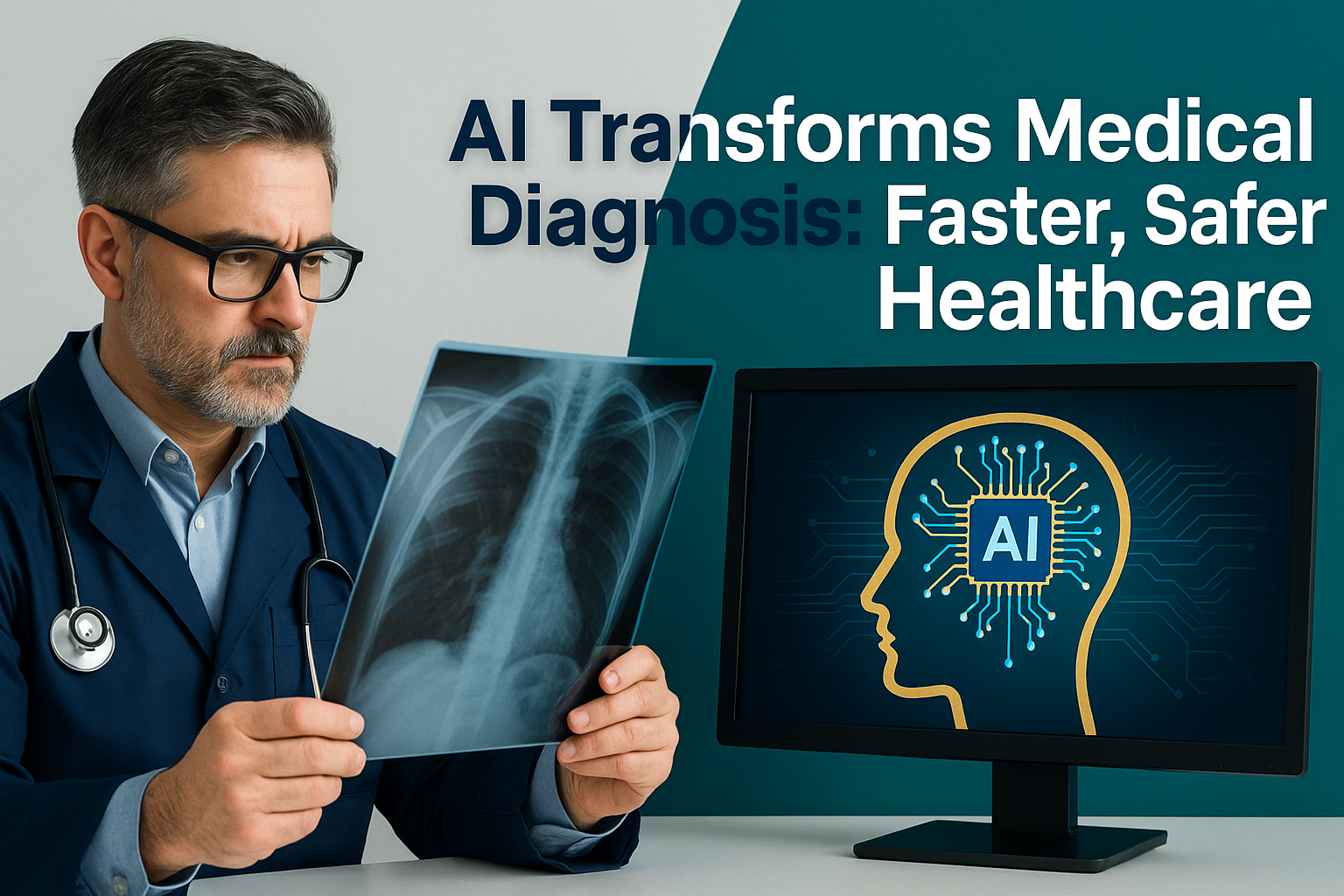AI Revolutionizes Medical Diagnosis: Faster, Safer, Smarter Healthcare
Intermediate | July 23, 2025
✨ Read the article aloud on your own or repeat each paragraph after your tutor.
Artificial intelligence (AI) is quickly changing how doctors find and understand illnesses, making diagnosis more accurate and efficient. This article explores the rise of AI in medical diagnosis and how it is transforming patient care.
Global Market Trends
This technology is improving patient care in many ways. The global market for AI in medical diagnosis is growing rapidly, from US\$1.71 billion in 2024 to an expected US\$4.72 billion by 2029. This shows how important AI is becoming in healthcare.
How AI is Changing Diagnosis
The Role of AI in Medical Diagnosis
AI is helping doctors detect diseases much earlier. New AI models can find early signs of over 1,000 diseases years before symptoms appear with over 90% accuracy, analyzing patient history and medical images. For example, AstraZeneca has created an AI model that uses data from 500,000 people for early detection.
Medical Imaging Improvements
AI is also making medical imaging safer. A recent Reuters report mentioned a new AI technology that can reconstruct 3D bone structures using only a few X-ray images. This reduces radiation exposure by a huge 90% to 99% compared to traditional CT scans. It also means patients wait less for their results. Furthermore, AI improves the speed and precision of interpreting brain scans for stroke patients, even identifying the stroke’s timeframe. Microsoft is also working to enhance AI models for medical imaging to help radiologists.
Beyond Diagnosis: Personalized Care and Efficiency
Personalized Treatments
AI is not just about detecting illness; it’s also making treatment more personal. By analyzing genetic information and vast medical data, AI creates unique treatment plans for each patient. Google’s DeepMind, for instance, can predict acute kidney injury 48 hours in advance.
Boosting Daily Workflow and Accuracy
AI is also helping healthcare professionals with their daily tasks. Tools like Microsoft’s Dragon Copilot can listen to consultations and create notes, reducing administrative work. This allows doctors and nurses to spend more time directly helping patients. AI can even predict risks, such as a patient needing a hospital transfer from an ambulance, or personalize lung cancer treatments. AI has even shown to be more accurate than human doctors in specific tasks, like identifying suspicious skin lesions or pulmonary tuberculosis on X-rays.
The Future of AI in Medicine
Market Growth and Potential
The growth of AI in medical diagnosis is strong, driven by government support, more funding for AI companies, and a lot of medical data available. However, there are still challenges, like a shortage of skilled AI professionals and a need for clearer rules about medical software. Even with these hurdles, experts believe that continued research and development are essential to fully use AI’s incredible potential in healthcare.
Vocabulary
- transforming (verb): Changing something completely, usually to improve it.
- Example: “AI is transforming medical diagnosis in many ways.”
- diagnosis (noun): The process of identifying the nature or cause of a disease or problem.
- Example: “Early diagnosis is crucial for effective treatment.”
- accuracy (noun): The quality or state of being correct or precise.
- Example: “AI models have over 90% accuracy in early disease detection.”
- exposure (noun): The state of being open to something, often harmful, like radiation.
- Example: “The new AI reduces radiation exposure significantly.”
- biomarkers (noun): Biological molecules that indicate a particular disease or process.
- Example: “AI analyzes biomarkers for early detection.”
- interpreting (verb): Explaining the meaning of something.
- Example: “AI improves the speed of interpreting medical images.”
- precision (noun): The quality of being exact or accurate.
- Example: “AI helps improve the precision of radiology reports.”
- alleviate (verb): To make suffering, deficiency, or a problem less severe.
- Example: “AI tools help alleviate administrative burdens in healthcare.”
- burdens (noun): A heavy load, or a difficulty or responsibility.
- Example: “AI reduces administrative burdens, freeing up doctors.”
- crucial (adjective): Extremely important, essential.
- Example: “Continued research is crucial to unlock AI’s potential.”
Discussion Questions (About the Article)
- What are some specific ways AI is helping to reduce radiation exposure in medical diagnosis?
- How accurate are new AI models in detecting diseases early, according to the article?
- Can you explain how AI helps with personalized medicine?
- What are some challenges mentioned in the article regarding the growth of AI in medical diagnostics?
- Based on the article, what is one surprising area where AI can outperform human diagnosis?
Discussion Questions (About the Topic)
- Do you think AI in medicine will make healthcare more accessible for everyone? Why or why not?
- What are some ethical concerns you might have about AI making medical diagnoses?
- How do you imagine a typical doctor’s visit might change with more AI involvement in the future?
- If you had a serious illness, would you feel comfortable with an AI making your diagnosis? Why or why not?
- What jobs in healthcare do you think might be most affected by the rise of AI?
Related Idiom
A shot in the arm
- Meaning: Something that has a stimulating or encouraging effect; a boost.
- Example: “The new AI technology has been a real shot in the arm for early disease detection in medicine.”
📢 Want more tips like this? 👉 Sign up for the All About English Mastery Newsletter! Click here to join us!
Want to finally Master English but don’t have the time? Mastering English for Busy Professionals is the course for you! Check it out now!
Follow our YouTube Channel @All_About_English for more great insights and tips
This article was inspired by: July 14 2025 – Reuters


